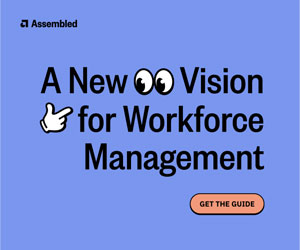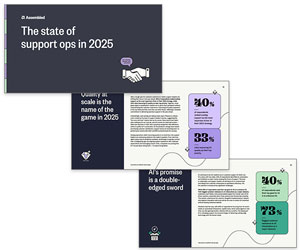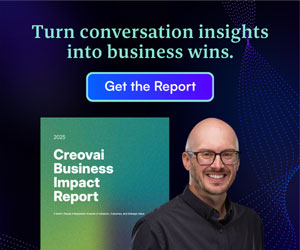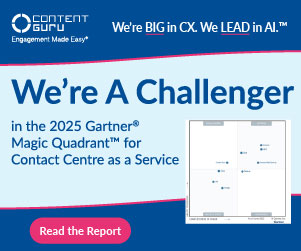Matt Rinkol, on behalf of Assembled, shares lessons from his decades in workforce management—from mastering peak planning and building world-class teams to preparing WFM leaders for an AI-powered future.
Like most people who end up in workforce management, Matt Rinkol just kind of fell into it. But he didn’t fall into it the way you might expect.
Matt was in finance, steadily building his career to become a CFO. Along the way, he identified a gap: operations. To close it, he took a job in workforce operations at PayPal – a role he assumed was “just a subset of finance.” Spoiler: it wasn’t.
“I fell in love with it,” he says. “It had all the math and people parts of finance – which I loved – and none of the accounting, which I hated. So it was a perfect match.”
That discovery kicked off a career-long commitment to WFM, with leadership roles at Facebook, Wayfair, and Chewy. In this conversation, Matt shares what enterprise WFM leaders can learn from his decades in the field – and what will separate the great teams from the rest in the years ahead.
Don’t Let Anyone Underestimate WFM
One of the first misconceptions Matt tries to break down, whether he’s talking to executives, cross-functional partners, or new hires, is that workforce management is “just scheduling.”
“They think it’s, ‘Everyone’s got a schedule. Here’s your schedule, and that’s it.’ Simple,” he says. “What they don’t see is the complexity underneath.”
Matt lays it out plainly:
“You’ve got arrival patterns, overlapping shifts, breaks, lunches, non-productive time, and all of that has to be calculated so you can still meet those arrival patterns.
There’s a lot of math in the background, and it’s not optional. If you get it wrong, your service levels drop, your queues spike, and the customer experience suffers.”
At the enterprise scale, making that complexity invisible is part of the WFM leader’s craft. “For our partners, we make it look seamless. That’s our job, to make something that’s actually very hard look easy.”
The gap between perception and reality isn’t just a communication issue, it affects tooling, too. Matt recalls his time at Facebook, where the complexity outpaced the capabilities of their WFM platform.
“We had a contract with Aspect, but they couldn’t react quickly enough. We needed changes in a week or two, and they needed months. That’s a lifetime in our world.”
The solution was to build a homegrown system with help from engineers, an experience that left the engineering team with a whole new respect for WFM.
“They started out thinking it was going to be simple. Once they started coding, they said, ‘Wow, this is a lot more complex than we ever thought.’ And they only realized that because they had to account for every scenario in software form.”
For enterprise leaders, the takeaway isn’t that you should always build your own tools, it’s that your tools need to move at the speed of your business and handle the real-world complexity you face. As Matt puts it, “If you can’t adapt quickly, you’re already behind.”
Plan For Peak When the Last One Ends
For Matt, seasonal readiness is the ultimate test of a WFM team’s sophistication, and it starts long before most people realize.
“The biggest thing is, you almost start planning for holiday season after that holiday season ends,” he says. “It’s a long planning cycle, and it’s more about hiring and upskilling than it is about anything else.”
Forecasting volume, he explains, isn’t the hard part. “We’ve got prior seasonal patterns we can use. We’ve got the current trends. But it’s about having the right number of people with the right skills in place at that time.”
That’s where backward planning comes in.
“Let’s say your peak starts the beginning of November, ramps up the second week of December, and you know exactly how many people you need.
You work backward: What’s the training time? What’s the ramp time? When do you need to start hiring so they’re fully productive during peak?”
For more complex skills, that timeline can be long. “If it’s a six-month ramp, you have to back out the whole calendar — and then add another two months just to get the hiring plan approved.
If your peak is November or December and you wait until summer to start talking about it, you’ve probably already missed your window.”
When the planning falls short, the impact is immediate — and painful. Matt recalls early days at PayPal when the team didn’t have enough people for peak.
“Service levels were in the 20–30% range, customers were waiting 20–30 minutes, abandon rates spiked, and volume snowballed because people were calling back. That taught me early on: if we want to avoid this, we have to be ahead of it.”
Even the right plan can fall apart without executive buy-in. Matt once presented a fully backed hiring forecast, only to have the CFO cut the budget.
“I told him, you’re going to put us in a deficit we can’t recover from for 6–9 months. Peak will be horrible, and everything after will be worse. Exactly what we predicted happened.”
When Leadership Has Your Back, WFM Can Soar
The contrast with his time at Chewy couldn’t be sharper.
“From the CEO down, everyone knew: we will take care of the customer. I never got an artificial cut to the customer service budget.
We went into every holiday season rightly staffed, no harsh environment, no crazy overtime. In fact, sometimes we could do VTO during off hours. That’s what happens when the whole company values the customer experience.”
Chewy’s commitment to service went beyond staffing levels, it extended to process improvements that directly supported agents.
One of Matt’s first discoveries there was that agents were manually choosing whether to answer calls, and sometimes hitting “ignore,” which risked missing their aggressive 90/10 service level target.
“I said, why aren’t we just delivering the call to the next available agent?” he recalls. The answer: they didn’t have after-call work enabled, so agents needed to finish wrap-up before taking the next call.
Matt and his team worked with engineering to enable after-call work and make calls auto-deliver when agents were available.
The impact was immediate. “Agents loved it because they could finish their wrap-up without the stress of another call coming in. And our service level dropped in half, our average speed of answer went from eight and a half seconds to four seconds. That’s unheard of.”
For Matt, Chewy was proof that when leadership and WFM are fully aligned, the results can be transformational, for customers, agents, and operational performance.
Grow the People, Not Just The Plan
If Chewy was about alignment from the top, Facebook was about building it from scratch. Matt’s proudest accomplishment in his WFM career isn’t a forecast he nailed or a peak season he sailed through, it’s the team he built there.
“I started basically on my own, with a team of about five people who didn’t really have workforce backgrounds.
We built that into a team of 110 workforce people with multiple different functions. We were solving problems no one had faced in workforce before.”
The key, he says, was surrounding himself with “the best and brightest” and creating an environment where they wanted to push themselves.
“Some people are happy just to come in, do their job, and go home. But I gravitate toward people who say, ‘No, I want to grow. I want to get to the next level. I want to take on more.’”
For those people, Matt made it a point to sit down and map out a development plan: “Where are your gaps? How do we close them? What’s it going to take to get you where you want to be?”
The results were exhausting, but worth it.
“It was the most challenging, stressful time in my career, but also the most rewarding. They were always coming to me: ‘What can I do more? Where can I learn? How can I help?’ Even now, years later, it’s amazing to see where their careers have gone.”
For new WFM leaders, Matt’s advice is simple: remember where you came from, keep developing yourself, and stay steady in the face of chaos.
“Give your partners and your team the confidence that you’ve got this, because if they see you steady, they’ll be steady too.”
The Future is AI – But Not Without People
Matt may be retired, but he admits it’s a “super exciting time” for WFM. “One of the things that might draw me back in is how we can use AI, not only from an agent perspective, but from a workforce management perspective,” he says.
“Using AI to help forecast, to help schedule, there are so many ways it can make us more efficient.”
But he’s quick to point out that efficiency comes with a shift in the skills WFM teams will need. “Typically, our analysts aren’t highly college educated, some didn’t go to college, some did.
And a lot of them are more about just running the procedure. I think we’re going to see a shift where you need to be a little bit more educated, because you’ll need to use AI tools to do your job well.”
His advice to current analysts: start learning now.
“If you can get sharp with AI, you can still have a great career. But if you don’t, you might find yourself pushed out of the industry as AI becomes more prevalent.”
On the agent side, Matt draws from his experience at Facebook, where AI eventually reviewed about 80% of content, but always left the gray areas to humans.
“AI is great with black and white. It’s not great with gray. When you’re dealing with customer issues, that’s a lot of gray.”
And then there’s the cost question. “AI isn’t free. There’s a cost every time you use it. So now it’s: what’s the cost per interaction with AI versus the cost per interaction with a live person? You have to make the trade-off.”
In Matt’s view, the best WFM leaders in the AI era will be the ones who embrace the technology without losing sight of the human element. “It’s going to be a completely different world, and a fun one, if you’re ready for it.”
And being ready, he adds, isn’t new territory for great WFM leaders, it’s the same formula that’s always driven success: staying adaptable, making the case for what the business needs, and developing people who can grow alongside the tools.
This blog post has been re-published by kind permission of Assembled – View the Original Article
For more information about Assembled - visit the Assembled Website
Call Centre Helper is not responsible for the content of these guest blog posts. The opinions expressed in this article are those of the author, and do not necessarily reflect those of Call Centre Helper.
Author: Assembled
Reviewed by: Jo Robinson
Published On: 19th Sep 2025
Read more about - Guest Blogs, Assembled






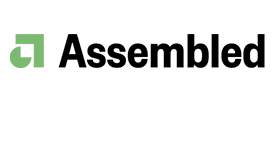 Assembled is a Support Operations platform that helps companies maintain exceptional customer experiences, no matter what lies ahead. Leading brands use Assembled's workforce and vendor management capabilities to make optimal staffing decisions, gain visibility into performance and productivity, and unlock new ways to serve evolving customer needs.
Assembled is a Support Operations platform that helps companies maintain exceptional customer experiences, no matter what lies ahead. Leading brands use Assembled's workforce and vendor management capabilities to make optimal staffing decisions, gain visibility into performance and productivity, and unlock new ways to serve evolving customer needs. 




